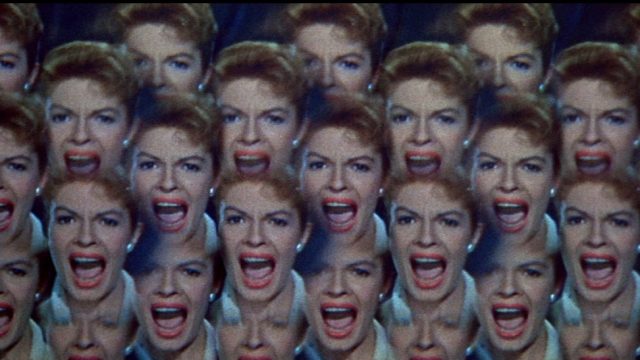“Help me. Helllllp me.”
There aren’t a lot of remade movies where both versions are worth their existence, but there are a few, sometimes each for the same reason and sometimes for different reasons. These days, David Cronenberg’s 1986 version of The Fly with Jeff Goldblum and Geena Davis in two of the best performances of their careers is certainly the best-known version of this story. But it’s worth looking back at the 1958 version, which while not at the heights of the 1986, is still a chilling little piece of work that deserves to be remembered better by science fiction and horror fans.
The movie starts out with a guard at an industrial plant discovering the body of one of his employers, Andre Delambre, with his head and arm crushed in an industrial press. At the same time, his wife Hélène calls her brother François (Vincent Price in the rare good guy role) and tells him that she has killed her husband, apparently with no motive or reason. Naturally, everyone thinks she might have been buckling under the stress of his disappearance or that she’s simply gone insane and murdered him for no reason. But one day, her nurse kills a common housefly and Hélène flips out, screaming, over the death of the fly. Under further interrogation by François and the local police inspector, Hélène tells her tragic tale.
This version, based on the short story by George Langelaan that the producers ran across in the early days of Playboy, has the same basic bones that you may be familiar with: in 1950s Canada, Andre is a basement scientist secretly working on a form of teleportation (here called a disintegrator-integrator). He barely sees Hélène (though it’s obvious they’re crazy about each other) because of how much he’s working on the machine. Then one day, he’s been missing for two days downstairs and neither Hélène nor François has seen him. Finally, Hélène sees a note slid under the lab door and enters the lab to be confronted by Andre’s hideous visage
Come to find out, he’s been experimenting with the machine and instead of integrating with a housefly, they’ve swapped heads and arms. It’s a pretty darn good makeup effect for 1958 and even though the actor David Hedison complained that it really restricted his ability to act, he’s doing a very effective job with it. (He spends a decent amount of time under a hood, too, unwilling to subject his wife to his new look.) Thus ensues a chase through the house as Hélène is searching for the white-headed fly that is the other half of the accident.
What makes The Fly, both versions, some of the more interesting films of their times is their focus on the female lead (here so even more than in 1986). Patricia Owens is really good as a woman who obviously loves her husband, is terrified for him, and also terrified of him and this hideous situation. She propels the action and helps her husband in his terrible conclusion as to what has to be done. And what has to be done, once they can’t find the fly, is a terrible thing…to destroy all the evidence of the experiment so this doesn’t happen to anyone else. Sadly, that evidence also includes him.
And that’s why Hélène finally agrees to help Andre end his life. She can see how much pain he is in, his mind slipping away as his brain becomes more fly than man. It’s an act of desperation, but it’s also an act of love. This movie is indeed one of the 1950’s “Man should not meddle in that which we should not meddle with!” reactions to the explosion of science and technology of the time, but it’s also about a loving couple who want the best for each other, even if that means someone has to end up in the hydraulic press.
I really do like this odd piece of fifties science fiction. It has many of the tropes of the time, up to and including some really great horror movie screaming from Patricia Owens, but it’s also doing some different things that work quite well. (It’s also rather lovely, one of the later works shot by Karl Struss, who also worked on Sunrise: A Song of Two Humans and The Great Dictator, in some beautiful CinemaScope color.) You can certainly see why Cronenberg decided to remake it; it’s material well-suited to his particular interests. It’s a tragedy wrapped up in science fiction tropes and its very much worth revisiting.
The tragedy extends to the infamous, terrifying ending. Andre’s body may well be dead, but his head is still out there somewhere. And François, considering whether his sister-in-law’s story might be true, gets the shock of his life when he sees a white-headed fly out in the garden, in a spider’s web, squeaking. But of course, it couldn’t be true, so François dismisses the sight of it as the police come for Hélène, until Hélène’s son drags François and the inspector out to the garden again…just in time to see a spider devour poor Andre. The inspector and François, shaken, can’t dismiss what they saw but obviously no one is going to believe them so they concoct a believable enough story that Andre committed suicide with the hydraulic press and free Hélène. How’s that for a bittersweet ending?
(As a final note, there’s a double-feature set of this with the 1986 The Fly that has a commentary by David Hedison, still with us at 92, and film historian David Del Valle that is very much worth your time.)

